#holmes basic
Explore tagged Tumblr posts
Text

Fighter, magic-user, and cleric battle a purple worm in the depths of the dungeon. (David Sutherland, a little scene found in the first and second editions of Holmes' Dungeons & Dragons Basic Set rules, TSR, 1977-78) An equivalent party of 3 faces the orc horde on the title page. The purple worm fight is similar but reversed compared to Sutherland's illustration in the 1977 AD&D Monster Manual.
#Dungeons & Dragons#D&D#David Sutherland#purple worm#dungeon#dnd#adventuring party#monster#Holmes D&D#Basic D&D#Holmes Basic#fighter#magic user#cleric#wizard#mage#magic spell#Dungeons and Dragons#TSR
173 notes
·
View notes
Text
No. 8 - B1, In Search of the Unknown (1979)
Author(s): Mike Carr Artist(s): David C. Sutherland III (Cover), David Trampier (Original Cover) Level range: 1, preferably party size 4+ players Theme: Tutorial Dungeon Major re-releases: Original Adventures Reincarnated: Into the Borderlands
A quirk of early DND that people sometimes forget is that you had to learn how to play this game. The assumption, prior to the Holmes Basic set being released in 1977, was that you knew a guy who knew how to play, in a kind of 1970s & Gary Gygax version of Six Degrees of Kevin Bacon. Holmes had obviously made a big dent in this, but still there were complaints about the game being confusing and hard to learn. In steps Mike Carr who made the following bold proposal:
What if we made a paint-by-numbers DND module to train new GMs with?

In 2024 you might scoff at this, because it feels an awful lot like they just sold you half a module and told you to finish that. This is an unfair read, but this is a genuinely good habit to instill early into a GM. Too many times have I seen a new DM just, run books entirely stock and then be confused why it went badly. This breaks the back of that habit very, very early.
For those of you that remain unconvinced, in the OAR re-release of Into the Borderlands they included three stocked versions of B1 (I recommend Version A). But: keep in mind! You could not tune into Critical Role, there was not a DND club at every major school, and the discipline of TTRPG design itself did not exist yet. This was a stab at teaching DND entirely via text, so we will see in time how good a stab they took at it.
Oh, and before I exit the intro blurb, let's say it explicitly: this is the first standalone Basic Dungeons and Dragons module. It was a pack-in with the Holmes basic set (which means you got the Tower of Zenopus AND B1, a pretty tidy bargain), alongside some depressing little dice chits, a little blue rulebook, and a coupon for some dice that are bad-in-a-highly-charming way. We are spoiled for dice now, back then you had to ink your own in CRAYON.
ANYHOW, let's begin.
Firstly, Carr begins with explaining some broad principles to an aspiring new GM, like the concept of keying, minions, xp, difficulty, GM arts, et c. He also recommends narrating the party as having already arrived at the dungeon, a conceit I think more GMs should entertain -- we all know that "we meet in a tavern" is a little played out, but I think it's played out mainly because it's done badly - meeting in the tavern served no purpose because the GM ultimately wanted to just hurry up to the dungeon.
The adventure proper starts with a quick blurb about two famous characters who in the wayback times built a stronghold, did some adventurin', fought some wars, but are now long gone. A separate account of this is included in the player-facing section (whatever happened to player-facing sections?).
We are given ol' reliable, a rumors table, where we learn very little of interest: The dungeon is called Quasaqueton -- a real place in Iowa, apparently the duo were slavers, and apparently the dungeon itself talks. It's generally wet and miserable here, and wandering about are a variety of very standard enemies (orcs, kobolds, trogs, rats). That's, basically all we get on the dungeon itself, so let's enter the highlights reel:
The very first thing that happens in the dungeon is simply adorable. Two magic mouths demand the party to defend their treasure-hunting ways, and then promptly tell them they're going to die oooOoOOOOooOoo! in a sufficiently melodramatic way. It also bugs you every time you revisit, which will turn it into a comedy on revisit. There is also the grisly remains of a previous party, as if to imply that these newbies are about to get HAZED. Given that this was likely the new GM and players' first go, I'd call even odds on it being a slaughter.
It is at about room V where I realize why roman numerals died off, as trying to figure out where room 5 is when there's many, many rooms with a V marking. Letters are preferable to roman numerals but truly it was a good day when we switched to circled Arabic numerals.
There is just something inherently funny about going into a wizard's closet and discovering that said wizard was a boring person with normal clothes and a bunch of mundane books about weather and plants. We also find out Zelligar has been absent for 30+ years from his closet-bookkeeping.
Teaching the kids early that wizards are assholes, in Zelligar's practice room there's a permanent illusion of treasure. It doesn't kill you like a Gary treasure would, it just makes you sad.

There is a weirdly elaborate table of jars? And one of the jars is a living black cat in suspended animation? The purpose of this room is, and I quote, "to surprise and/or mystify the adventurers, as well as to provide some fun for the DM". There is no treasure or monsters pre-stocked in most any of these rooms (as per the conceit) but I think it would be GM malpractice to not put SOME kind of fucked up jarred magic item here. That there is no potions in this room feels particularly odd?
There's a riddle in the wizard's lab that, isn't actually a riddle? It's just talking funny. Large swaths of this dungeon feel like they should be a funhouse and have loot pinatas scattered around, this is one such room. Instead, it's…just kind of a self-aggrandizing sign, like a weird motivational poster.

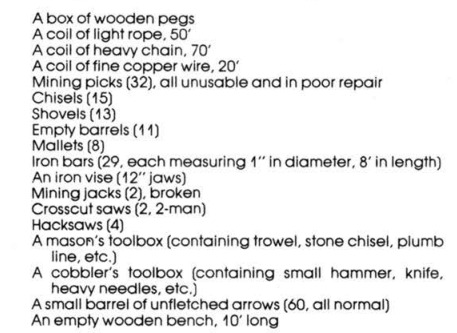

I know the conceit of the dungeon is that this is someone's home and stronghold but it kind of just feels like someone's Minecraft fort? I really feel like we're going to walk into a room full of chests contain 94 doors and 4,000 grass seeds any minute now. And I guess that food is 30 years old? The inscrutable letter codes make me long for a dAlphabet.
It feels kinda weird that fire beetles fell out of use. "Magic lightning bugs that infinitely fuel lanterns without igniting in swamp gas" is a super handy conceit.
We have a super classic portcullis trap with a elegant twist: because the lever to lift the trap is strength-based (sum of strength scores), it almost definitionally separates the squishies from the tanks. The downside is, unfortunately, that it's functionally a save or die trap despite not instantly killing you?

It's also really interesting how the fantasy of bending the bars went away. That used to be such a big thing in the superman tv show era. I have yet to have a modern player even consider it. Not surprising it stopped being in rulebooks though.
There is one of the regulation early DND troll traps, where a mapping party is to be intentionally tricked and given false descriptions because a doorway is also a teleporter. It is explained somewhat poorly, which is particularly unfortunate for a tutorial dungeon, but the jist is that once they pass through the doorway you should rotate your map and act like you haven't started describing rooms turned 90 degrees. Because early DND kind-of assumes the party moves as a blob while in dungeoncrawl mode, you can't get split up by this, despite the fact that "realistically" it would totally do that. A weird quirk of this description is that, I have no idea when they bold words. You think they're bolding for emphasis but it's acting like they're bolding keywords, but prior to this they only bold spell names and the bar-lifting. Afterward it's mostly spells and a sole keyword.

I'm getting mixed messages here. I get why it's here, but come on.
The coverart is a reference to a specific garden room which has overgrown in the wizard's absence. It is, ultimately, just a pretty room with a slight hazard if a random encounter happens there. "The room on the cover is inexplicable and unrelated to the rest of the dungeon" is funhouse-y behavior IMO, but the rest of the dungeon is a series of vaguely plausible rooms assembled in a maze-y way. Which is as good a segue as any to briefly talk about the overall layout.
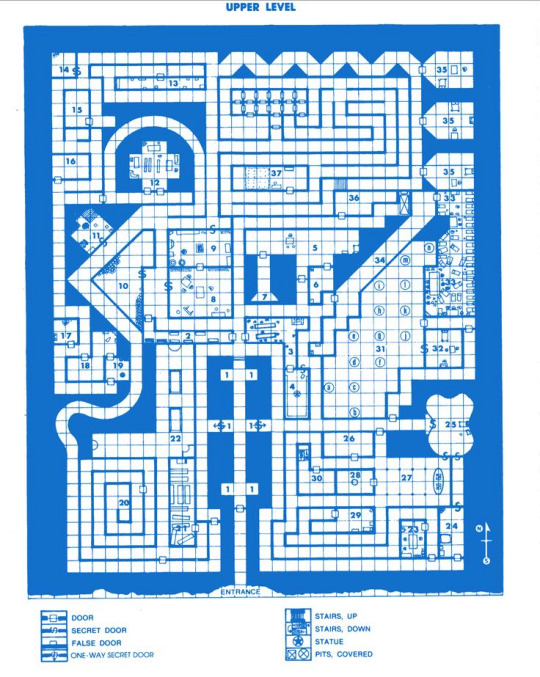
This is a bad layout. This is a layout you come up with when you are just procgenning maze dungeons over and over again. As we have demonstrated in previous posts, this is just kind of how it was in the 70s. This kind of works as a mapping challenge, but mostly it comes across as tedious for everyone involved. Who would make a living space like this? Even the most cooked adventurer on the planet would not install multiple maze corridors for…no reason? AND THE EXCESS OF SECRET DOORS. A friend described this as "a map you could almost make in Wolfenstein 3D", which is actually a great metric. If I can make your map in Wolf3D, it's bad.
There is a genre of dungeon room I like to call "gambler's traps", which is when the room contains like 10+ weird things that you can poke, and if you happen to poke the right ones you get some nice things, and if you poke the wrong ones you get pain. Invariably, you will have a player who tries to poke every one of them, offsetting the whole room. Pools of stuff are traditional, so we get pools. Tragically, every pool with a conceivably fun effect magically stops working outside the pool (come ON Carr!) and many are just pointless A few of them are totally devastating (one of them silences your voice for d6 hours), a few of them are slightly good. In what is a complete dick move, there is an acidic pool with a key at the bottom that does absolutely nothing.
Sigh you find the guy who advised the building of Quasqueton's room, with documents about the construction of it, but explicitly no information that could possibly help adventurers. One of the few magic items in this dungeon is locked in a drawer, but odds are it's nothing interesting (pray for your +1 Ring of Protection)
So the big maze corridor has a regulation spring-loaded trapdoor, which dumps you downstairs sans inventory into freezing cold water. Kinda mean but, sure. Traps are kind of an underrated artform, I feel like GMs as a group have just given up on them. That being said, traps like this one…do not sell me on traps as a concept.
Finally, we go to the lower level, which is not worth talking about in detail. Essentially, these egotists made a museum to themselves down here (for who?), there's a magic rock that if you eat it (??) has a d20 table of permanent effects skewing positive, and another pit trap. So, how to feel about B1 on the whole? It's not really remarkable. Really its most famous quality (you will key every single room) is its sole interesting quality. It's an early 70s dungeon that is starting to feel dated by 1979. I think that 5e-ers would benefit from a B1-like paint-by-numbers module, really. B1 is no Tower of Zenopus. I think we will all be much happier come B2, that (while far from perfect) has a strong identity and a comparative cohesiveness.
10 notes
·
View notes
Text
All the World’s Monsters Readthrough
The following has not been proofread. It may contain typos, I may use the same words or phrases too many times, and so on. Tumblr also removes a lot of formatting such as underlines. Maybe I'll fix or update it in the future; maybe I won't. (Things like underlining being removed is beyond my control.) If there are serious corrections as regards facts presented, I will definitely amend such points. Please feel free to comment such corrections; or any comments at all. I want to read through with all of you!
All the World’s Monsters:
A Readthrough, Part I
Longwinded Introduction
This is a feature I’ve been wanting to work on for quite some time. Originally I wanted to write it with another person, and had various ideas on how that would work, but that didn’t happen. It’s a readthrough of the world’s first monster collection for an RPG. That I’m aware of, anyway - there very well might be some obscure or unsung prior volumes on the same topic(at the very least, perhaps zine monster collections?). I’m talking about Chaosium’s All the World’s Monsters. It’s an interesting book for sure, in a number of ways.
For one thing, not so much had become standardized. What information was important to know about a monster might vary by personal taste or by the specific version of the game being played. All the World’s Monsters was released after Holmes Basic but before the AD&D Monster Manual, which was the first of the AD&D books to be released(because I guess they figured people could still use the monster stats with other versions of the game while they completed the other core books).
Holmes Basic, for those unaware(and I won’t go into it too far because you can find plenty of histories on this out there with all the detail you’d like - skip this paragraph if you know about this already), was created as a way of introducing people to the D&D game as presented in the original white box set and Supplement I: Greyhawk. It was also a way of teaching people how to put those pieces together, or at least, one of the ways to do it, since the white box game was sort of all over the place, and difficult for people to grasp - especially if they had no prior boardgame knowledge beyond Monopoly and no wargaming knowledge. It kind of assumed you knew a lot of terms of general procedures for the more advanced board games and such, and that you would otherwise fill in the blanks. Holmes Basic did that for you. Furthermore, and it’s my understanding that this was more of a “Gygax shoehorning stuff he wanted in” aspect, but there are a few references to AD&D concepts and even the game itself, such as the exhortation to purchase AD&D if you wished to know how to have exotic characters like halfling thieves, or progress beyond 3rd level. (With the OD&D books you could do that anyway, and this was just a sales pitch.) It also introduced something closer to AD&D’s alignment system, except that you couldn’t play any neutral character besides a true neutral one: no neutral good, no chaotic neutral(there goes half my players!).
There’s a lot to say about this version of the game, and some people play this one exclusively, even coming up with retroclones such as Blueholme! And some of what I have to say on it will be relevant, because All the World’s Monsters was written with the assumption that Holmes Basic reflected the standard we would be seeing from that point on, including little oddities never to appear in any other edition or version of D&D ever again!
Another thing that makes the book so intriguing is, being the first of its kind, there were so many monsters out there that hadn’t been statted yet - at least in a published book that others could look at and draw inspiration from. So until they got statted in AD&D’s Deities and Demigods, who could argue, “officially,” how many hit dice a shoggoth should have, what its AC should be, and so on? The original books gave no stats for any kind of sphinx - what would an androsphinx’s HD be? Same as a lion? More? What’s a lion’s HD anyway? Spotted lions are listed in the OD&D encounter tables, but there are no statistics for them(in the white box set, anyway). Or how about an elephant - how many HD should it have? What should its AC be? While the white box told us that rocs are sometimes large enough to prey on elephants(an incredible concept rendered rather banal now by overuse), it didn’t tell us what statistics an elephant should have. How would you stat it, without peeking at your MM? Guess, what would you give them? Highlight the following for the answer:
Tumblr won't allow me to set text to white because why would it? I'm leaving the "highlight the following line" bit out of stubborness at not allowing the formatting I require. (11 HD, AC 6)
So at that time, there were a myriad animals and monsters that had never before seen print in the form of D&D/AD&D statistics. This gives a lot of room for creativity - you couldn’t look at some other book and say “Gee, I gave this monster 9 HD, but the official ones are 4/this unofficial supplement gives them 5. Did I overrate them that badly?” Maybe so, maybe not.
Statting animals and monsters is more art than science, though there’s some of that, too. The fact is, these are fairly arbitrary measures, and if you attempt to work out the official stats and come up with some kind of formula, you’ll drive yourself insane. Many things in the game, admittedly, were varied for the sake of variation. Weapon damage, for instance, was stated to have been made up for the purpose of variety - there’s no real reason that one weapon causes 2d4 while another causes 1d8 other than providing a wide spread of different dice types and combinations for weapons. (Yes, 2d4 gives you a bell curve with average score of 5 and a minimum score of 2, but the reason for this wasn’t because the weapon itself logically should, but rather to provide a variation.) I suspect that wolves being described as far smaller than they actually are was for a similar reason - wanting lower-level characters to be able to fight creatures that low-level monsters(goblins) often ride, but also to offer dire wolves, wargs, etc as upgrades. (Which still could have been done with properly-sized wolves, so maybe I’m barking up the wrong tree…)
Not only were so many animals and monsters unstatted, but again - formatting, and even rules weren’t fully codified or formulated yet. To some degree, many wouldn’t be until 3e made a concentrated effort to make everything formulaic with very specific processes and rules for everything, as well as to “balance” every monster and class, a task monumentally failed. As a good example of the lack of cohesion, look up monsters that strangle or drown and see how many different ways it’s done. I’m not saying this to knock the “old way” - there’s a reason I play old versions of D&D almost exclusively. Restricting yourself with unnecessary formulas and intricate templates is not typically of benefit, and having the flexibility to model things in different ways is superior to having to consult a list of codified formulas to make sure everything adds up.
But at this stage, even some of the few things that became standards had yet to come into play. In most instances, there were no examples to follow to determine, say, how almost any given special ability a creature might have should be modeled. So even this had to be determined by what were essentially fans writing for their favorite game.
As you can see, this was an exciting time, and an incredible opportunity - to set in black & white, in numbers, all the different things that D&D/AD&D classifies as “monsters” - anything that isn’t a PC! Setting down on paper, for the first time, so many different monsters. Devising rules for powers and abilities that nobody had created(at least publically available) rules for. Incorporating rules that would only exist for one basic introductory iteration of the system. (Not that they knew that!) Having the chance to determine formatting and all kinds of things that nobody had yet done.
Worlds and cosmoses full of things that still needed to be expressed in numbers and ability descriptions were waiting to be codified. This was, in fact, one of my misconceptions about the book when I purchased it - I thought it was more like Monsters of Myth and Legend by Mayfair as part of their Role Aids line, where they went through all different world mythologies and folklore in order to stat out all the various legendary monsters. All the World’s Monsters was really just a compilation of monsters submitted to Chaosium, and most of them are provided by but a handful of people - but we’ll explore that as we get into the actual readthrough.
Book Description

The first thing one will notice, besides for the eye-catching red background with stark black art, is that it’s sideways. It’s designed to be flipped or turned “up” from the bottom, so the spine is to the top. Similarly, the back cover is read sideways, spine upwards. I don’t need to do a critique or commentary on the art here; it’s pretty cool. I’m pretty uncritical of art, especially in low-budget/indie publications, and especially if the content is otherwise good.
To the back cover, we’re told the book is “an encyclopedia of the strange, the bizarre, and the deadly,” with “265 monstrous and dangerous creatures,” all by creators from the North American continent(or at least, most of it). We’re given sample stats for a kodiak bear - remember, there weren’t(to my knowledge) stats for any bears yet. (I didn’t consult the back cover before writing the bit about bears, previously.) Actually, we’re given the description, not the full stats - so we can’t read through and critique a set of stats just yet! But there’s an interesting part even here.
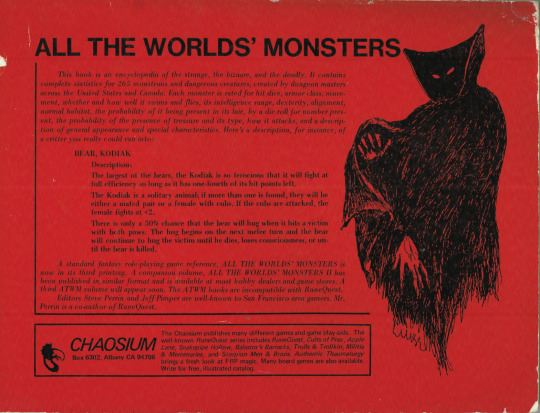
For instance, the description mentions that the kodiak can “fight at full efficiency so long as it has one-fourth of its hit points left.” There were some optional rules in OD&D that included dexterity reductions and various penalties at different percentages of HP loss. Such rules are difficult to implement, particularly at low levels, when a small hit will often take 75% of a PC’s HP, and adds yet another element(or two or three or four) to track. Regardless, people surely used those rules, and I imagine this part of the description was a special ability that applied only to those using these kinds of rules.
A kodiak mother gains bonuses in combat to protect her young and kodiaks have a chance of a hug attack, nothing too noteworthy or mind-blowing.
We end with a note about this being the third printing(it’s what I’ve got), there being another volume out, and a third on the way, and a line about the editors. Steve Perrin is one of them, and the blurb mentions that he’s the “co-author of RuneQuest,” a game I like very much, personally. Then some info about Chaosium and where you can write for info and so on.
The book itself is 109 pages, with the last 3 pages unnumbered, as they are tables, specifically, a monster level chart, to help with placing the monsters found in the book on the appropriate dungeon level, and a table for creating random monsters. Perhaps we’ll roll up a few in a future installment for fun.
The Book’s Introduction Page
Opening the cover we get a title page and introduction. If you thought the sideways book was just a feature of the cover - it’s not. The whole book is like this. And I have to say, I tried to be open minded about it. I told myself “You’re using it the same as you’d use any book except for how it’s turned, it doesn’t actually make any difference.” I hate when something is done in a new way and everyone rejects it because it’s different. While I can see the flaws in it, I really loved the Monstrous Compendium stuff made with hole-punched pages for sorting in a looseleaf binder. I feel like it failed less because of the flaws in it and more because it seemed too different, and was simply dismissed out of hand. So I try really hard not to do that.
But the format really bugs me.
Moving on to the introduction, I have to wonder how close this is to whatever introduction was originally written, since it opens by mentioning that this is the third printing. Mr. Perrin goes on to tell us that it was made for “games such as Dungeons & Dragons, Tunnels & Trolls, and the Arduin Grimoire.”
I have a few comments on this. Originally I wanted to say it was neat how this early one could simply reference D&D like that without a problem, but apparently the book did, in fact, cause a stir with TSR. I have not listened to the linked podcast, but the description says that this was the case. Once this readthrough is complete, I’ll go back and listen to the podcast; I’d like to get my own impressions, and maybe make a few guesses at some things, and see if I’m right or how much my ideas mesh with what they say.
Tunnels & Trolls(another game I quite like) is interesting since it didn’t really have monster stats, so using these in that game would be more for descriptive flavor.
As for the Arduin Grimoire, for those unaware, it was originally written as a sort of expansion and add-on to OD&D. This, too, caused problems, and it eventually became its own game(despite never playing it, its monster the “vampusa��� remains a favorite of mine to this day). Gary Gygax mocked it in the form of a cursed item in AD&D, a book that drives the reader insane(one might have assumed it was a Lovecraft inspired item, but its inspiration was pure spite).
It goes on to tell us that they have 50,000 monsters, and how they might not use yours and how they chose the ones that went in here, info about the art, where to mail feedback about the monsters you want to see. What’s of real interest here is the mention that Dave Hargrave and Paul Jaquays gave them permission to use some of their own copywritten monsters, but these had to be removed due to space limitations. They then recommend Mr. Hargrave’s Arduin Grimoire(I’m sure that helped endear them to TSR), among other things, as well as several publications by Jaquays. These were presumably the publications from which the monsters would have been taken, and we’re told they will be in future volumes of AtWM.
Table of Contents
Skimming through, there are some really neat looking ones.
Archer bush? That was a later Mystara monster adapted into 2nd ed and currently 5e(not sure if it was in 3e or 4e or not and don’t particularly care). Sometimes it’s hard to say if multiple people had the same idea or one ripped the other off. Especially in this early time when lots of people were putting out monsters and few had previously, people were bound to have similar if not identical ideas. Such things have happened in much less likely circumstances.
Some very odd ones right off the bat. Snake ape? On the other hand, things like “air squids” are why I read these kinds of collections.
Batarang. Was DC ever notified of this infringement?
Plenty of slimy monsters: blue horror(which I’m guessing is a slime-type?), red blob, maybe “brown ich?,” gelatinous blue horror(maybe the original isn’t a slime after all), green slime golem. Eh, maybe not as many as I thought. We’ll get a better idea as we read through them, I don’t want to spend all day browsing the contents. And neither do you, I’m sure!
Vampire bear. Heh. Brain stealer(geteit chemosit). Is that German? I feel like I’ve seen other monsters in here with similar names. Will have to see if that’s true and if they’re written by the same author.
Carnivorous… typo? Carnivorous typo. Typo, carnivorous. Are you serious? If this doesn’t end up being some kind of meta monster I’m going to be quite disappointed.
Here’s another thing about the formatting. It makes sense as a normal book, in that one column continues in the column to its right. But because of the formatting of the book, you expect it to continue down the column on the next page below it. It’s a small thing, honestly, but it’s noticeable.
A lot of monsters that would see official stats later, as expected. Crocotta, cyclops, various demons - but no devils! There’s a “sun devil,” but since there’s no “devil” category I figure it’s a devil in the way a tasmanian devil is a devil - in a non-literal sense. It looks like there are some traditional powerful monsters from myth and legend among the demons, as Ymir(“Prince of Ice Demons”) is one of them, and some of these others may turn out to be similar things - it’s hard to tell from the names, such as “serpent king” and “twelfth plane,” which yes, is the name of a demon. As three demons are listed as “ice,” I imagine they were going more for a frozen Hell as opposed to a fiery one, which would be why they used Ymir instead of Surtr. The latter would have been a much more obvious choice, being a fiery giant who is to burn the universe to ashes as the grand finale of the final conflict between good and evil(yes I’m simplifying it, this isn’t a mythology lesson).
A good number of golems, including diamond, dust, the aforementioned green slime, ice(unusual but not impossible in a magical world, or in frozen places, where they’d be quite evocative), quicksilver(which would also appear in Mystara as simply “silver golems”), wood(ditto), and oddest of all - tar.
Ground octopus, like “air squid,” is the kind of thing I read these books for. Again, there’s kind of a similar monster in Mystara, the decapus, which tends to live in trees. Personally, my favorites are the octorocks of the Legend of Zelda series. While mentioning both air squids and video games, I’ll throw in that the Japanese Super Mario Bros 2 featured flying squids as well. I should also mention that I haven’t played video games in 30 years, so I will routinely recall things like this and not the 3,000 instances of them that have likely appeared in video games in the interim.
I never thought I’d see triffids in a monster book. I love it! Some Lewis Carrol monsters, some from myth and legend, such as the “three sons of Argatron.” I had to look that up, by the way, as it sounded historical but I wasn’t sure. Google corrected me to some random other word first, and then when I insisted that it search for what I actually typed, it pulled the legends right up. I didn’t read them though; we’ll do that when we get to the entry! Man-Scorpion, another monster not yet statted. As far as I know, they’re usually called “scorpion men,” so the formatting of “man” first is an unusual coincidence and I wonder if there was some famous or classical text popular at the time that used that form. At any rate, it says “see Humbaba,” who, if I’m not terribly wrong, was not a scorpion man.
There are several Lovecraftian things, including stats for Nyarlathotep. I believe I have probably 3 or 4 sets of stats for him, for various editions of D&D, and I look forward to contrasting them all and seeing how they compare, especially this earliest one to, say, the newest one I have. Of course, being published by Chaosium, they had the rights to these monsters.
Not so much the olog-hai, which was a direct property of the Tolkien Estate. If “hobbit,” a word Professor Tolkien did not even invent, had to be removed from early versions of D&D, one must imagine that the only reason the same didn’t occur here is that this book flew under their radar. (In fact, I believe hobbits were removed by choice, in order to prevent future legal issues, but this is another point I could be quite wrong on.)
Let’s move on and not spend all day speculating and rambling about a table of contents, shall we?
Creators
I don’t want to add up the number of creators used, as many are combinations of creators and so forth. Dan Pierson created the largest number of monsters, with 28 entries printed in the book. It seems like the average is about a dozen or a bit less, just glancing at the numbers and guessing. If someone cares enough to do the math, have fun.
One little point is the last line: “There are 265 entries and 113 cross-references.” So out of these monsters, almost half of them are related to(in some way or another, whether as biologically related, as enemies, or whatever) others. If that’s what it means, that would make some sense given that some creators contributed a dozen or more monsters, and there’s often going to be such connections(such as someone creating a number of “ice demons”). This kind of thing is good, as it can be incorporated to give the denizens of your world, and your world by extension, more of a feeling of depth and history, that these monsters have relations, alliances and rivalries, and aren’t just a set of numbers.
“Interpreting the Monster Entries”
An explanation of what the stats mean and so forth. There are a few points of interest here. They mention that random numbers are “expressed as die rolls,” in case you played D&D and somehow didn’t know what 3d6 meant. This is great though, as it saves the trouble of figuring out what to use to determine 3-6(it’s 1d4+2). There are reasons that Gygax chose to express numbers as, say, the aforementioned 3-6 instead of 1d4+2, which was to emphasize that the numbers were important and not how they were generated, opening people up to new dice rolling conventions and so forth. Unfortunately, what it mostly did was confuse people with some of the more difficult to interpret number ranges.
We’re told that intelligence is abbreviated as IQ(as it is in the later GURPS) and expressed as a die roll - so instead of being told “very” or given a specific number, we’re given dice to roll to determine the intelligence of any given monster. (I do this in my own games and monster stats, so it’s nice to see someone else doing this a number of years before I was capable of playing.)
Most of the rest of the explanations are mundane and not worth reviewing, it’s basic information.
One thing it doesn’t bother to explain or mention is the fact that it has a dexterity range for each monster in the same way it has an IQ range. Here, dexterity is abbreviated DEXT., which makes me wonder if the DEX abbreviation had been used yet on character sheets or was still a little bit away? Remember, this book was released after Holmes Basic and before a single AD&D book, including the first AD&D book released, the Monster Manual.
More importantly than the abbreviation is why that was there. It was there because in Holmes Basic, the melee combatants attack in order of dexterity, regardless of who won initiative or initiated combat. The Holmes book mentions the question of “who strikes the first blow?” as one unresolved in OD&D, which seems very odd. OD&D never really explained initiative at all, and expected you to default to Chainmail order of initiative. It may have not expected you to use the combat “phases,” but just the die mechanic that determined which side acted first - that being a d6 and the higher goes first. Later versions would have the lower roll act first, with the option to positively/detrimentally modify the roll by weapon speed. There is mention that dexterity might affect various things including initiative, but there’s no exact rule explaining how. Most people just assumed that the one with the initiative attacked first, and this was how the game has been played, for the most part, ever since(and I imagine, for most, during and before, as well). Personally, I think it’s great, and would enjoy trying the rule out. I favor using phases and aspects of combat that add some amount of strategy, where “I run up and attack” can often be detrimental to waiting for a more opportune moment and so forth. I’d prefer the combat phases, and have played with them for many, many years, but I’d be quite open to the Holmes Basic version of combat. (Someone want to run it for me?)
As yet another digression, it’s funny how often I’ve played games with people that ran their system of choice for decades, sometimes since the game was released, and never knew how initiative actually worked in said system. People get so used to it working a certain way in lots of games, and they either never consult the rule in their own game, or forget it and replace it in their mind with another. I’ve played in multiple Marvel Super Heroes games where everyone rolled a d10 for initiative, and when I pointed out it was one die per side, the judges in each case looked at me quizzically and then continued doing it how they had been doing it forever. The fact that they had been performing the most basic part of their favorite game wrong for 30+ years was too much to consider so it was simply dismissed.
And with that, I’ll wrap this first entry. I hope it wasn’t too boring - I know I ramble and digress, but it’s kind of part of the point I suppose. I hope you’ll stick with me for the monsters, even if you found this part kind of weak, and that you’ll let me know what you think, as well, because I want to go over this with you, not just read a review to a brick wall. It’s not a review, it’s a readthrough, me and you, if you please.
So.
Let’s read All the World’s Monsters together!
#D&D#AD&D#tunnels and trolls#arduin grimoire#chaosium#OD&D#holmes basic#holmes blue book#monster manual#all the world's monsters#readthrough#read through#review#osr#rpg#rpgs
1 note
·
View note
Text
first rule of fandom is everything goes back to destiel
second rule of fandom is everything goes back to kirk/spock
third rule of fandom is everything goes back to holmes & watson
fourth rule of fandom is everything goes back to achilles & patroclus
#plato was debating whether achilles was a top or bottom in 385 BC. the more things change the more they stay the same#< I'm not joking. there's a whole bit about it in plato's symposium#he basically argued that achilles is prettier and therefore a twink and therefore the eromenos and therefore a bottom#fandom#destiel#kirk/spock#spirk#holmes x watson#johnlock#achilles x patroclus#patrochilles#supernatural#star trek#sherlock#bbc sherlock#sherlock holmes#the iliad#the song of achilles
2K notes
·
View notes
Text
if there's one thing about classic literary detectives it's that they are not conventionally attractive. doyle told sidney paget to stop drawing holmes so pretty. christie was like "let me introduce you to this short pudgy balding man who is retirement age and i hate him." sayers compares wimsey to maggots on literally the FIRST PAGE
i love it. i love them. stop casting hot people in these roles. we need our detectives to be Charmingly Weird-Looking
#red randomness#acd holmes#poirot#lord peter wimsey#sherlock holmes#hercule poirot#peter wimsey#100 and up neat#the contrast in resulting authorial attitudes also ends up being somewhat amusing#christie basically wanting to kill poirot but going 'i gotta give the people their pompous little guy. and also it's money.'#doyle constantly wishing people would read his other worse books#and then sayers comes in like 'hey remember the guy i kept comparing to a slug? yeah i'm marrying him to my self-insert'
4K notes
·
View notes
Text

275 notes
·
View notes
Text
A Different Kind of Queen of Crime- five ways that Dorothy L Sayers changed the way we see Sherlock Holmes
For my first Holmesian post- a crossover with one of my more usual subjects on my other blog! For when one is talking about Sherlock Holmes, in particular Sherlock Holmes scholarship, there are nor many more pivotal names than Dorothy L Sayers. Sure, Christopher Morley may have had a greater impact on Sherlockian culture, and Richard Lancelyn Green on Holmesian scholarship, to name only a few- but Sayers's contributions to scholarship and "the game" were early and underratedly pivotal.
If you're a Sherlock Holmes fan who is unfamiliar with Sayers's influence, or a Sayers fan who had no idea she had any interest in Holmes, keep reading! (And if you're a Sherlock Holmes fan who wants to know what I think about Sayers, check out her tag on my main blog, @o-uncle-newt. Or, more to the point, just read her fantastic books.)

There's a great compilation of Sayers's writing and lecturing on the topic of Holmes called Sayers on Holmes (published by the Mythopoeic Press in 2001), though some of her essays are also available in her collection Unpopular Opinions, which is where I first encountered them. It's not THAT extensive, and it's from an era in which Sherlock Holmes scholarship, such as it was, was still very much nascent. While a lot may have happened since Sayers was writing and talking about Holmes, she got there early and she made an immediate impact- and here's how:
She helped create and define Sherlockian scholarship: Don't take this from me, take it from the legendary Richard Lancelyn Green! At a joint conference of the Sherlock Holmes Society and Dorothy L Sayers Society, he said that "Dorothy L. Sayers understood better than anyone before her the way of playing the game and her Sherlockian scholarship gave credibility and humor to this intellectual pursuit. Her standing as an authority on the art of detective fiction and as a major practitioner invigorated the scholarship, and her...Holmesian research is the benchmark by which other works are judged. It would be fair to say, as Watson said of Irene Adler, that for Sherlockians she is the woman and that …she 'eclipses and predominates the whole of her sex.'" We'll go into a bit more detail on some specific examples below, but one important one is that, as Green notes, Sayers was not only a mystery writer but an acknowledged authority on mystery fiction, whose (magisterial) introduction to The Omnibus of Crime, a then-groundbreaking history of the genre of mystery fiction, included a highly regarded section on the influence of Holmes on mystery fiction. She was able to write not just literate detective stories but literate critiques of others' stories and the genre (as collected in the excellent volume Taking Detective Stories Seriously), and as such, the writing she did on Holmes was well received.
She cofounded the (original iteration of) the Sherlock Holmes Society of London: While the current iteration of the Society lists itself as having been founded in 1951, a previous iteration existed through the 1930s, founded as a response to the creation of the Baker Street Irregulars in New York and run by a similar concept- the meeting of Sherlock Holmes fans every so often for dinner at a restaurant. Sayers, who seems to have been much more clubbable than Mycroft Holmes, helped run the Detection Club on corresponding lines as well. (Fun fact, Sir Arthur Conan Doyle was invited to be the first president of the Detection Club! However, he refused on grounds of poor health and, either right before or right after he died, the Detection Club met for the first time with GK Chesterton as president.) While the 1930s society didn't last, and Sayers didn't decide to join the newly reconstituted club in 1951, her presence from the beginning was key to the establishment of Holmesian scholarship.
She helped define The Game: Sayers didn't invent The Game, as the use of Higher Criticism in the study of Sherlock Holmes came to be called. (The Game now often refers to something a bit broader than that, but it's a pretty solid working definition to say that it is the study of Holmes stories as though they took place in, and can be reconciled with, our world.) Her friend Father Ronald Knox largely invented it almost by accident- as Sayers described it, he wrote that first essay "with the aim of showing that, by those methods [Higher Criticism], one could disintegrate a modern classic as speciously as a certain school of critics have endeavoured to disintegrate the Bible." This exercise backfired, as instead of finding this analysis of Holmes stories silly, people found it compelling and engaging- and this style of Sherlockian writing lives on to this day in multiple journals. Sayers, with her interest in religious scholarship as well as Holmes, was well equipped to both understand Knox's original motivations as well as to carry on in the spirit in which further Game players would take his work, as we'll see. She also wrote the line that would come to define the tone used in The Game- that it "must be played as solemnly as a county cricket match at Lord's; the slightest touch of extravagance or burlesque ruins the atmosphere." While comedic takes on The Game would never vanish, her establishment of tone has lingered, and pretty much any in-depth explanation of The Game will include her insightful comment.
Some of Sayers's ideas became definitional: Here's a question- what's John Watson's middle name? If you said "Hamish," guess what- you should be thanking Dorothy L Sayers. (When this middle name was used for Watson in the BBC Sherlock episode The Sign of Three, articles explaining its use generally didn't bother to credit her, instead saying that "some believe" or a variation on that.) She was the one who speculated that the reason why a) Watson's middle initial is H and b) Mary Morstan Watson calls Watson "James" instead of "John" in one story is because Watson's middle name is Hamish, a Scottish variant of James, with Mary's use of James being an intimate pet name based on this nickname. It's as credible as any other explanation for that question, but more than that it became by far the most popular middle name for Watson used in fan media. Others of Sayers's ideas include that Watson only ever married twice, with his comments about experience with women over four continents being just a lot of bluster and him really being a faithful romantic who married the first woman he really fell for (the aim of this essay being to demolish HW Bell's theory of a marriage to an unknown woman between Mary Morstan and the unnamed woman Watson married in 1903, mentioned by Holmes in The Blanched Soldier); that Holmes attended Sidney Sussex College, Cambridge (she denied that he could have attended Oxford, having gone there herself- fascinatingly, Holmesians who went to Cambridge usually assert that he attended Oxford! Conan Doyle of course attended neither school); and reconciling dates in canon (making the case that one cannot base a claim for Watson's mixing up on dates on poor handwriting as demonstrated in canonical documents, as it is clear from the similarity of different handwriting samples from different people/stories that they were written, presumably transcribed for publication purposes, by a copyist).
She wrote one of the only good Holmes pastiches: Okay, fine, I'm unusually anti-pastiche, and genuinely do like very few of them, but this is one that I love- and even more than that, it's even a Wimsey crossover! On January 8 1954, to commemorate the occasion of Holmes's 100th birthday (because, of course, he was born on January 6 1854- Sayers was more in favor of an 1853 birthdate but thought 1854 was acceptable), the BBC commissioned a bunch of pieces for the radio, including one by Sayers. You can read it here (with thanks to @copperbadge for posting it, it's shockingly hard to find online), and I think you'll agree it's adorable. The idea of Holmes and Wimsey living in the same world is wonderful, the way she makes it work is impeccable, and it's clearly done with so much love. Also you get baby Peter, which is just incredibly sweet!
I got into Dorothy L Sayers, in the long run, because I loved Sherlock Holmes from childhood and that later launched me into early and golden age mysteries- but it was discovering Sayers that brought me back full force into the world of Holmes. Just an awesome lady.
#hm holmes quotes from shakespeare's twelfth night a lot#he must have an affinity for the play.#sherlock holmes#john watson#john hamish watson#holmes#acd holmes#sherlock holmes canon#sherlockiana#the game#watsonian#biblical higher criticism#dorothy l sayers#lord peter wimsey#ronald knox#sayers on holmes#so why was sherlock holmes born on january 6?#if you think you know why#no it's stupider than that#so this guy christopher morley who basically invented sherlockian scholarly fandom#as in he started the baker street irregulars which is the org from which pretty much all other scholarly fan societies got inspiration#was like “hm”#“holmes sure does quote from twelfth night a lot”#“he must have an affinity for the play.”#“and why would he have an affinity for the play? because the twelfth night (jan 6) is his birthday.”#and so it has remained ever since#making clear the advantages of being first
202 notes
·
View notes
Text
it was supposed to be casual why the fuck did it take over my life
#this post goes out to every fixation i've basically ever had <3#but more specifically#the moomins#moomin#moomins#snufmin#!!!!#snufkin#!!!!!!#moominvalley#sherlock holmes#john watson#johnlock#young royals#lord of the rings#lotr#the lord of the rings#sam x frodo#my lovelies <33#the hobbit#bagginshield#oh yeah and#star stable online#/#starshine legacy#uhhhh and also#jurassic park#jurassic world#there's more but i can't put any more tags now😔
173 notes
·
View notes
Text

something bad’s about to happen to me
why i feel this way, i don’t know maybe
#tgaa#tgaa chronicles#tgaac#art#great ace attorney#the great ace attorney#dgs#fanart#herlock sholmes#sherlock holmes#dgs sherlock holmes#dai gyakuten saiban#lyric quotes#dark red by steve lacy#idk i had this visual stuck in my head for a couple of days#dgs2#dgs2 spoilers#i feel like after really marinating in whatever the fuck happened in 2-5 i have come to realize how scary this man is#i’ve been watching a play through to see if i can catch anything i couldn’t on my own play through and like#dude he drops so many hints and foreshadowing it’s fucking crazy how the fuck do you know all of this mr sholmes!!!!#he will always be a silly character but i cannot help but remember how genuinely unsettled i was by the way he acted at the end of 2-2#and also the time in the waxwork museum where he was questioned by susato and ryunosuke#where his trolling characteristics were basically implied to be a bit of an act#and i was like. damn. holy shit. because i almost fell for that act too. i almost believed him until he said smth like#‘but that won’t fly with you’ or something and ryunosuke affirmed it by saying that anyone else could’ve made a mistake but not mr sholmes#augh. he’s just a really good character ok
347 notes
·
View notes
Text

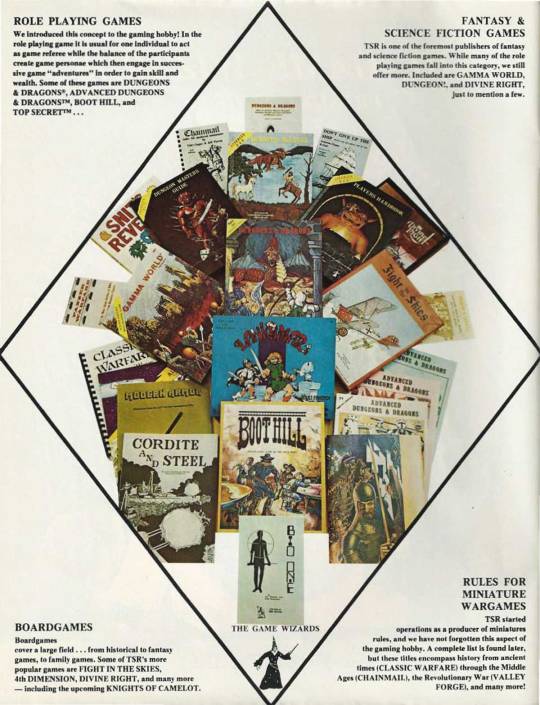
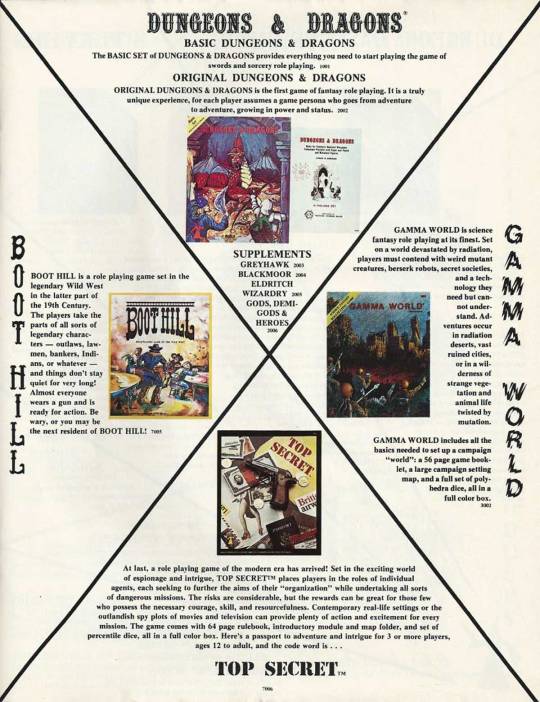


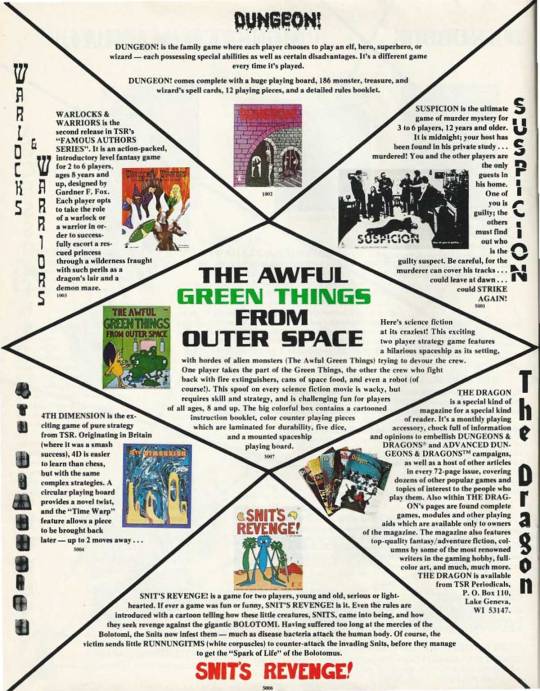
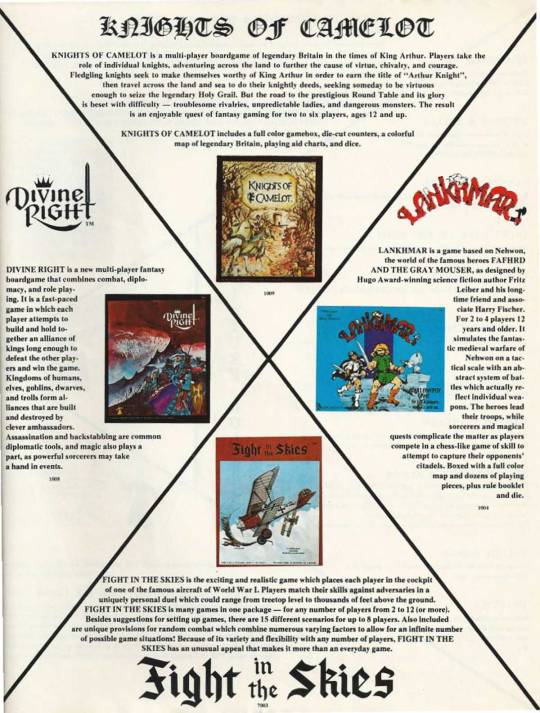
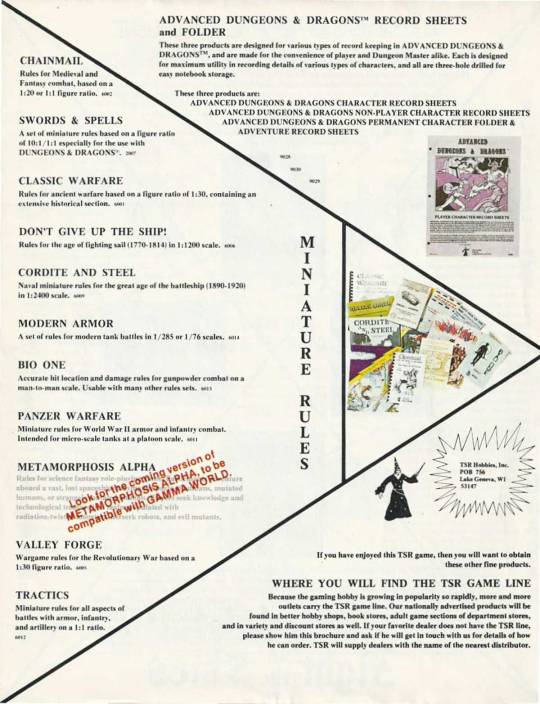
TSR Hobbies "Gateway to Adventure" catalog -- This version was included in TSR's boxed games ca 1980. Inside are many well-loved classics, some rarities, and probably the final appearance of many of their historical miniature wargame rules. The original D&D box set of 3 little books was still offered for sale, now in a white box marked "Original Collector's Edition," because it continued to sell and make TSR money even alongside Holmes' Basic set and the hardcover AD&D books. The last page teased an update to Metamorphosis Alpha to make it compatible with Gamma World (oddly listed in the "Miniature Rules" section), but that version never was published.
#D&D#Dungeons & Dragons#dnd#gaming history#Metamorphosis Alpha#Gateway to Adventure#game ad#dungeon door#demon#The Game Wizards#Dungeons and Dragons#OD&D#Basic D&D#Holmes Basic#Holmes D&D#AD&D#TSR#TSR Hobbies#TSR Hobbies Inc
146 notes
·
View notes
Text
No. 7.5 - 1978 Reflections, and the Halls of Mystery
Welcome back to the end-of-the-year recaps! This is technically the first TSR iteration of it!
1. Coolest ideas
It's a lot of stuff from D2. The big ticket item is "neutral-ground hostile shrine" -- any time you can muck about with otherwise hostile people without drawing swords immediately is a big win. I know that the reaction table is supposed to mitigate that some but, cmon. Sometimes you just can't think of a good reason that the 9th goblin pack tonight is not immediately hostile. This is a way more natural way to handle it. And it lets you talk and such and experience their culture from their perspective!
2. Coolest Module You Haven't Heard Of
This is honestly a hard one because all of these modules are intensely well known. Gun to my head, I would probably vote for G1. The D-series is cool but frankly there have been more better and more interesting iterations of subterranean hexcrawls -- Veins of the Earth being the currently famous one. But the thing about G1 is, G1 is a surprisingly natural and fun location. Unlike the others in the GDQ series, G1 is genuinely an adventure you could slot anywhere with no context. It is simply a fun raid on a fortress, which I never get tired of. The twists of "they're piss drunk" and "there's a slave revolt in the basement" are really good (albeit in 2024 a little stale) twists on the classic raid-on-fortress formula.
3. The Growth of Module Design
Honestly 1978 represents a rather stagnant year for module design. The most innovative design feature I see is how D1-D3 feeds into one another in a much more naturalistic way than its predecessors, and all through that deeply useful combination of hexmap and random tables with a handful of pre-programmed setpieces. I am eager to see hexmap technology get much better going forward.
…
Surprisingly, 1978 wasn't too much to talk about? I don't generally think of Gary as an "innovator" in module design space. His main contribution is taking things that already exist and making them feel more natural. Which is not to say that I now buy into Gygaxian Naturalism as this great feat, more than a lot of his competition at the time was seemingly intentionally anti-Naturalism. Their work feels like the reaction to me, Gary is just staying the course of "this should make an amount of sense". Although, his random dungeon monsters mishmash still feels as nonsensical as all hell.
The Halls of Mystery (From Dragon 21, December 1978)
And as threatened, we're going to have a very brief section on The Halls of Mystery, which holds the dubious honor of 1st Dragon Magazine dungeon. I would throw the full header at you, but everything is by Don Turnbull. You may recognize his name, at publication time he works for Games Workshop and he will be heading up TSR, Inc.'s UK branch starting in 1980, leading to the much-beloved Fiend Folio.
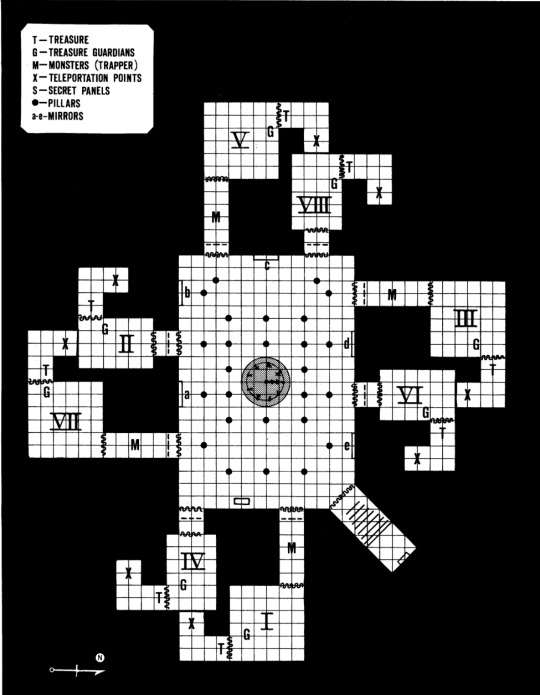
So. Not much to say about this, actually, It's a very large room with some branches. The main schtick of the Halls is that the main chamber contains several mirrors, some of which are magical. There's a big riddle on the desk on the south side, the riddle solution is actually quite obvious (say Excalibur three times -- and hey, Don told us the answer and rationale of the puzzle! Thanks Don!). When you move the central cylinder, it teleports you to the corresponding position in the dungeon. The rest is a lightweight stocking of the dungeon with monsters, treasure, et c. If you're keeping score, this is a Zelda puzzle. It's very cute and lightweight and honestly it's so neutrally written (no statistics are given and it would be trivially easy to restock it at any level) that you could genuinely use it in 2024 with very little effort. It's adorable! It is also wonderfully lean, clocking in at two total pages and frankly it's super refreshing to have such a light read of a module here.
Happily, next time we will be covering B1 - In Search of the Unknown, which is the second Basic D&D adventure we will be reviewing in this series (The adventure printed in the Basic rulebook, Tower of Zenopus, was first. This is our first lettered Basic adventure.) And, funnily, the first TSR module in this lineup I've never read before. See you then!
8 notes
·
View notes
Text
I'm rewatching sherlock for the first time since 2017 and omg I forgot just how many times johnlock are assumed to be a couple or are compared to one. I genuinely didn't remember that it was multiple times in every episode??
And then we were the insane ones for picking up on this "subtext"??
#my english proficiency wasnt bad back then but now im basically fluent in it i cant believe how much i missed back then? insane#bbc sherlock#tjlc#sherlock#johnlock#sherlock holmes
311 notes
·
View notes
Text
why is it always "I love you" and never "Sherlock is actually a girl's name" "Why is she like this" "You keep me right" "You look sad when you think he can't see you" "people will talk" "I'd be lost without my blogger" "because you're an idiot" "you were the best man and the most human human being" "i don't have friends, I've just got one" "yes, of course i forgive you"
#basically all the times they said “I love you” without actually saying it#bbc sherlock#johnlock#sherlock holmes#john watson#johnlock incorrect quotes
267 notes
·
View notes
Text
thinking of this gif but with johnlock,,,,,

#i’m insane sorry#someone sedate me#this basically applies to any johnlock btw#sherlock holmes#john watson#johnlock#sherlock fandom#wilde 1997
190 notes
·
View notes
Text
sherliam nyc life art dump 2023 (not including arts that already had separate posts in my blog) (unless i forgor)
warning long post

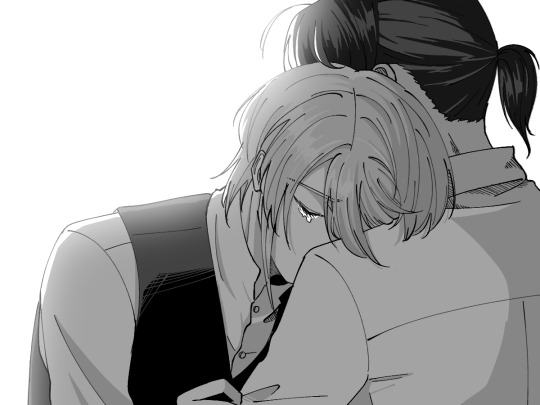
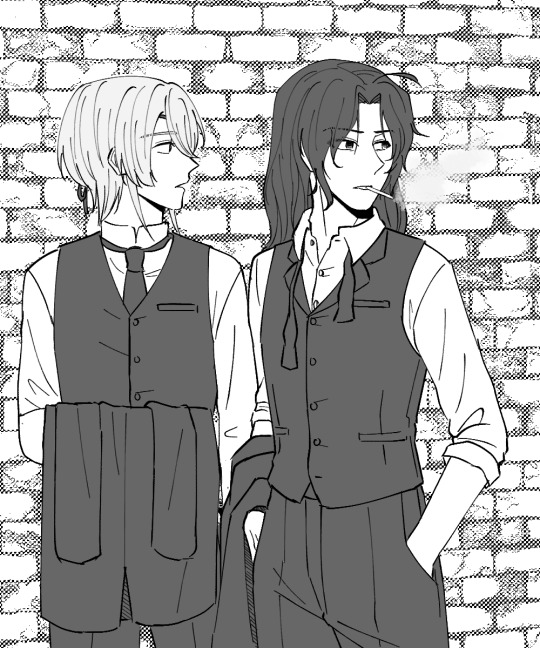

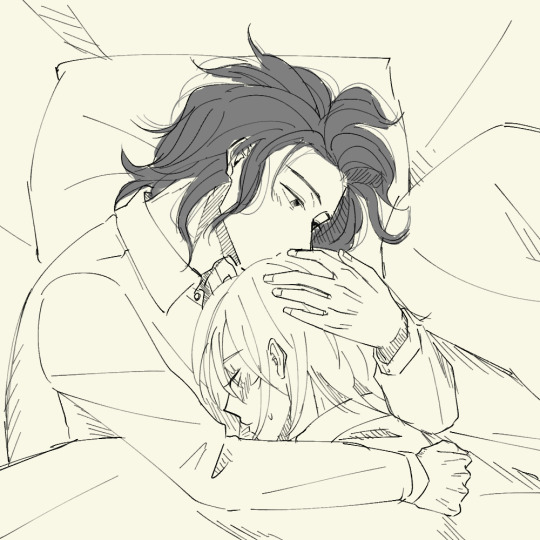
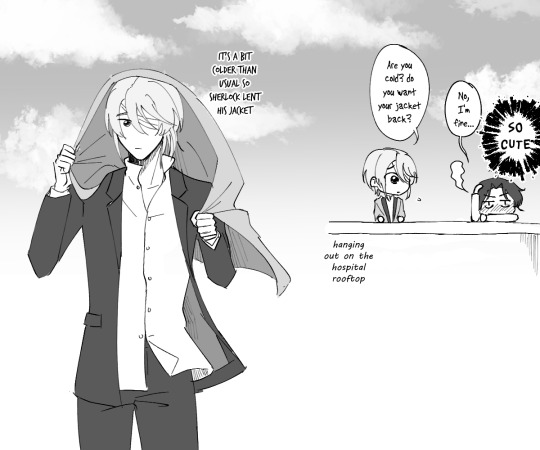
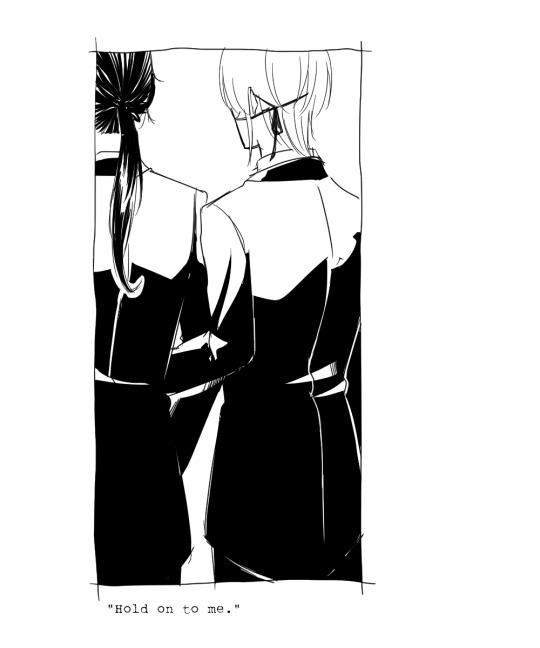

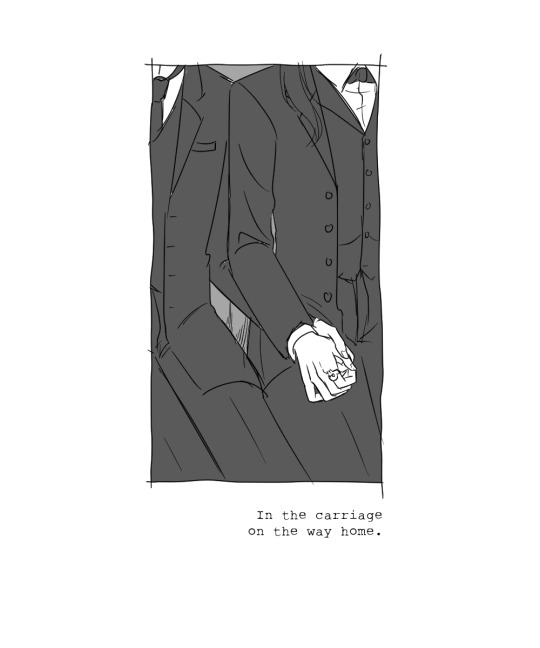
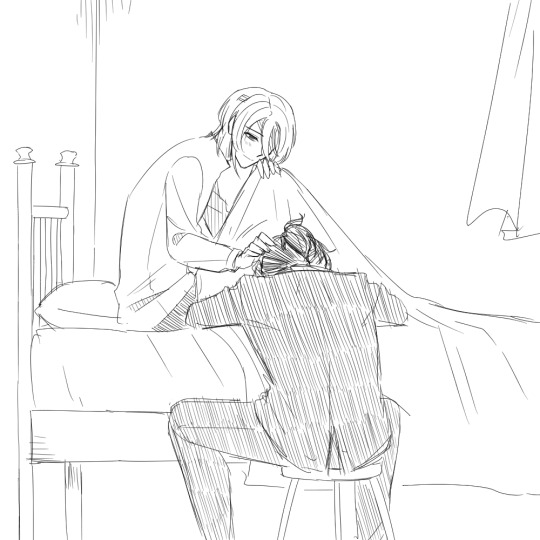
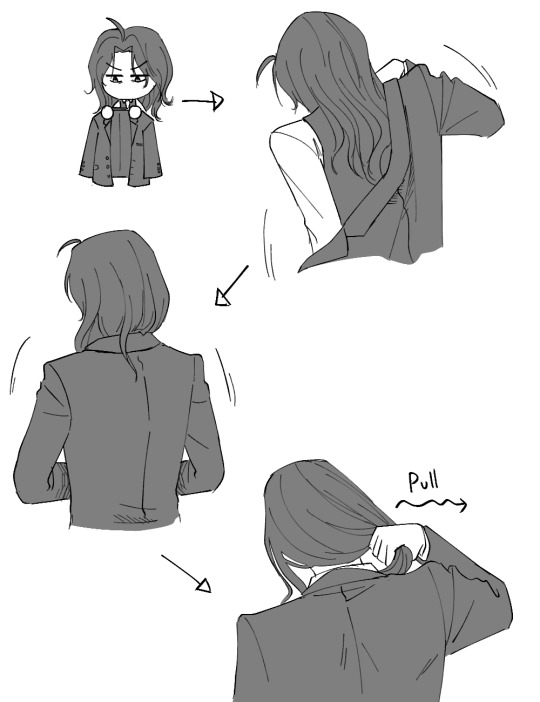
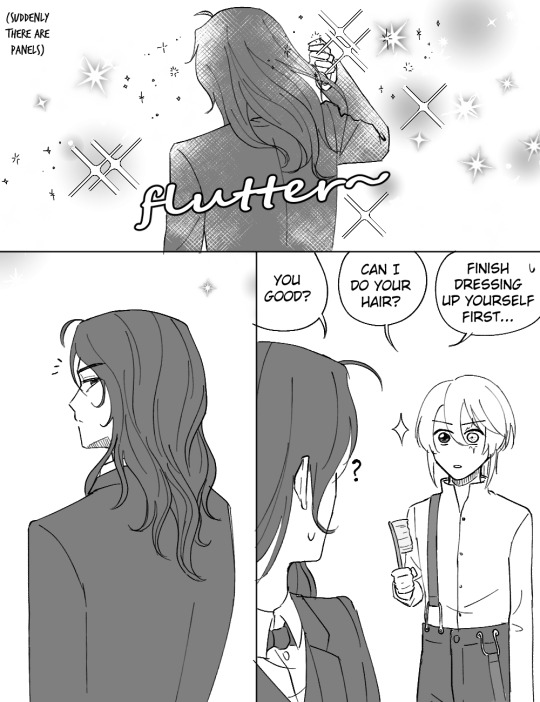
(↑ something super specific about sherlock's hair that i think of often)
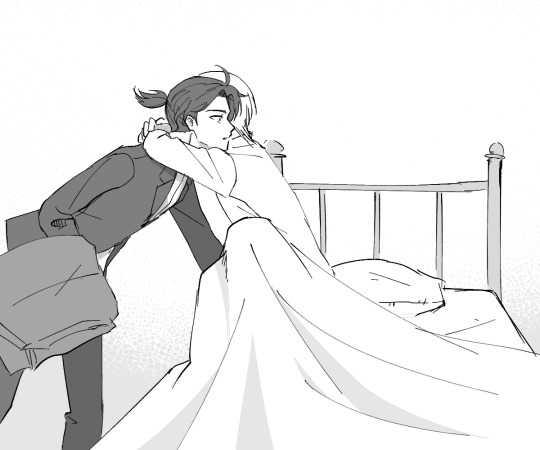
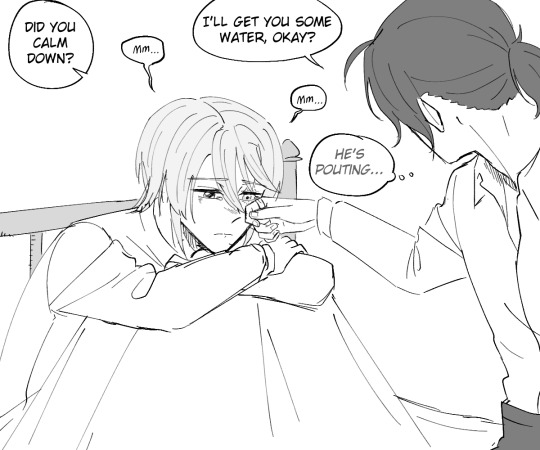
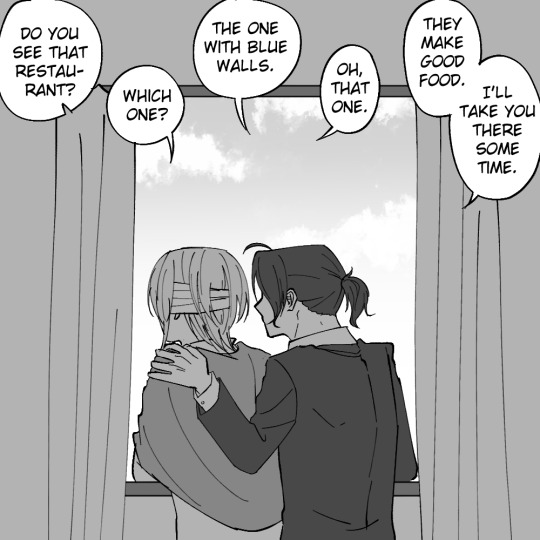

(↓ 3 drawings below are connected story-wise)
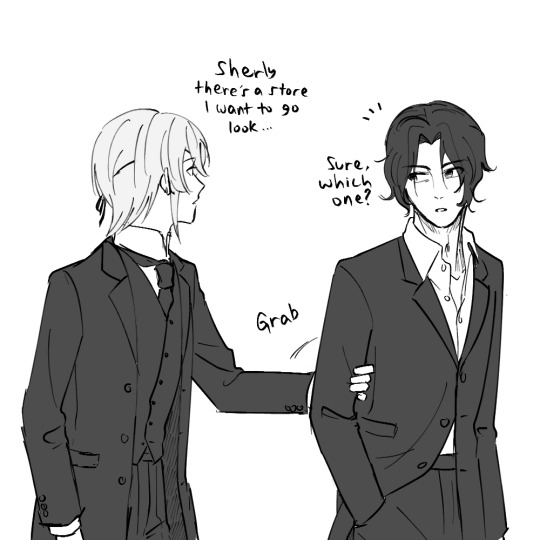



(↓ morning routine for some reason)
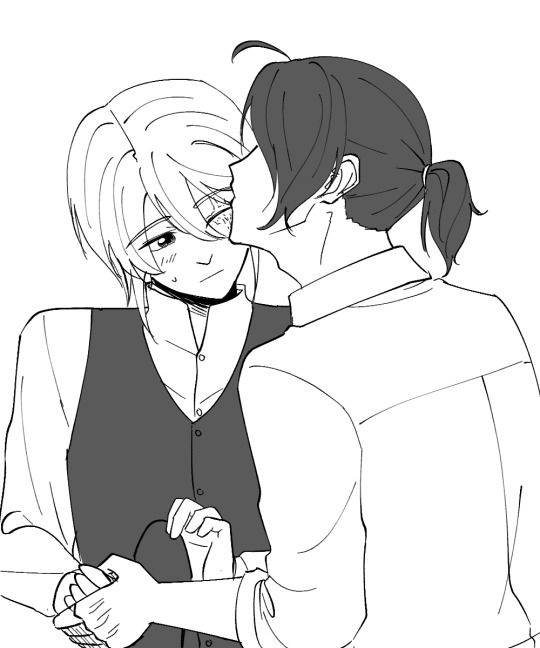

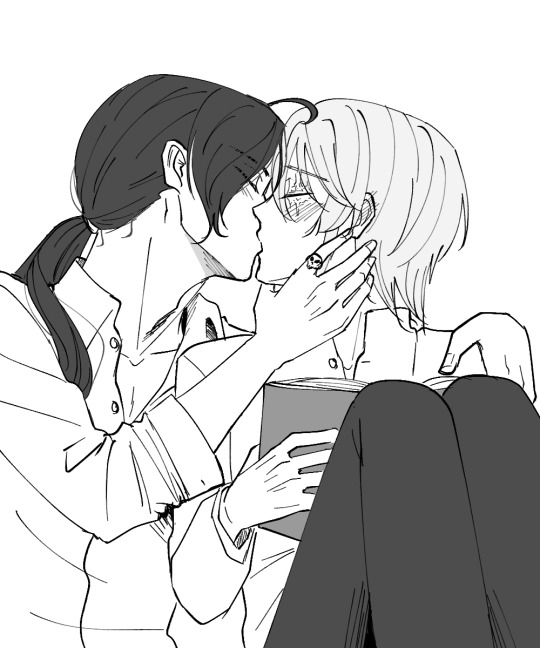

(↑ based on this merch)
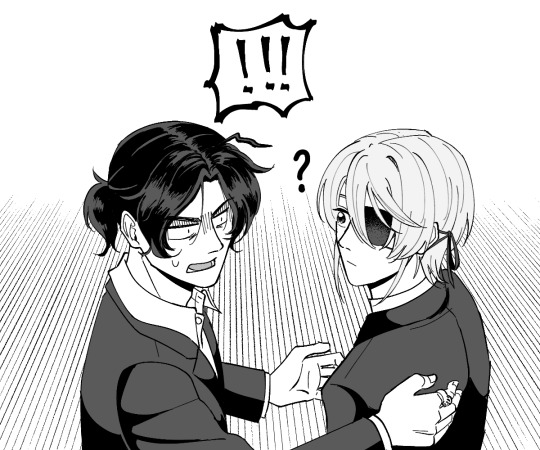

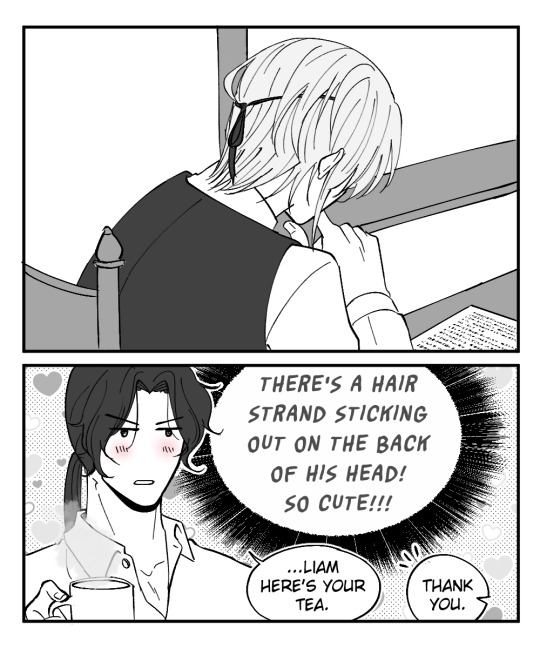
(↑ they're both the same)

i ended up not drawing as much as i did last year and i failed to be active here again (haha) but nevertheless thank you for your support in 2023 as well :) happy new year, i hope everyone is healthy and happy always
#sherliam#william james moriarty#sherlock holmes#moriarty the patriot#yuukoku no moriarty#yuumori#my art#by the way the drawings are in chronological order#as in first drawing is from january#and the last one is from december#(because i save my art files chronologically like that as well)#i actually just wanted the post to be just images but#there were some that needed more context#so i basically added explanations#which were just... how i captioned it on twitter#(cause i'm lazy)#do people read these tags? thank you if you're reading until here
1K notes
·
View notes
Text

SOMEONE PLAY THR ACOUSTIC BERSION OF THE SHERLOCK BBC INTRO QUICK OML
#WHOS HER JOHN AND DONT SAY MATT OTHERWHISE IM PUSHING MYSELF OFF A CLIF#AND SHES A CINICAL BITCH#IM A STORYTELLING GODDESS MUAHAHHAHA#your basic queerie#patti lupone#Sherlock holmes#or should i say#patti holmes#fuck it we ball#sherlock bbc
77 notes
·
View notes